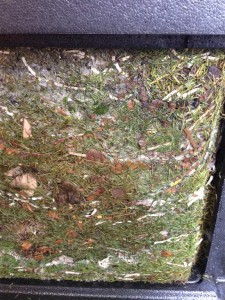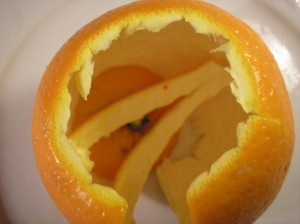Waste “Too Wet” to Hot Compost
Occasionally it can be a struggle to get the HOTBIN up to 60C. One of the most common issues is the waste is “too wet” for hot composting. In this post we explain what this means and how to fix it.
What does ‘too wet’ for hot composting mean? You have more water in the food waste than energy (calories/heat) available to evaporate the water as hot steam. If you do not balance a wet mix, the waste will not get above 40C, it will turn smelly and a lot of leachate will drain from the base.
We appreciate not achieving 60C can be frustrating and no-one wants a smelly bin. You bought the HOTBIN to resolve these issues. The answers are for HOTBIN hot composting. The advice might not match your past composting experience. Please stick with us – the advice works, it is based on the fundamental laws governing hot composting. Once grasped, you will find the HOTBIN easy to use for ever.
When is my waste “too wet” for hot composting? It is a challenge because it relates to the water inside the food waste. The waste does not need to be “dripping wet” to be ‘too wet’. As a rough rule of thumb:
- Garden waste is OK (it is usually 40-60% water)
- Vegetable peelings are OK (about– 70% water)
- Food waste is too wet (averages 80%). Always balance food waste
- Foods like salads, juice pulp and cooked food are excessively wet (90% water)
What are the signs my waste is ‘too wet’ for hot composting?
- Lots of leachate (brown water) leaking from mesh plate, (Check the water is definitely seeping from behind the mesh plate and ignore condensation and lots of water dripping off the inside of lid when you open it)
- The waste in the HOTBIN smells putrid, rancid or drain like (ie it is anaerobic)
- The temperature in the top layer will not increase above 30-40C. (Poor aeration and lack of new waste also prevents temperature rising above 40C – so check these as well).
Tip: Always investigate and fix excess water issues – the sooner you address, the easier it is to fix. Sorting out an anaerobic smelly mush of partly composted food waste is just about the worst composting job there is.
How do I fix (balance) waste that is too wet? By adding a dry ‘easy to digest’ waste into your mix. The easy and available material to add is shredded office paper and/or chopped up corrugated cardboard.
Tip: avoid adding newspaper or cereal packet card for this task. They are not easy for bacteria to digest and will just end up as a mushy lump in your final compost.
How much paper do I need to add to food waste? 30g of dry paper per 1Kg of wet food waste. This is one part shredded paper for every two parts of food waste. See the table below:
|
Full food waste container (by volume in litres) |
||||
| Container | Kitchen measuring jug | Small plastic kitchen waste caddy | Medium kitchen waste caddy | Full carrier bag, plastic bucket, or large food caddy |
| 2 litres | 5 litres | 9 Litres | 18 litres | |
| Measure of paper | 1 litre | 2.5 litres | 4.5 litres | 9 litres |
| Add this many hands full of paper per full container | 1 | 2-3 | 4 | 8 |
| Ratio by volume | For every full container of food waste, add half the same container of shredded paper. (The volume ratio is 2 parts food waste to 1 part shredded paper). | |||
To fix top layer, you may need ½ a carrier bag of paper/cardboard pieces (360g).
To rebalance a ¾ full bin, you may need 2 full carrier bags (1.4Kg) of paper.
Do I need to add bulking agent if using paper? Yes, ALWAYS add bulking agent with food waste. The bulking agent will form a supportive structure that maintains airflow.
Remember: In hot composting, paper fixes wetness, wood chip helps aeration. You cannot balance ‘wet waste’ by adding wood chip bulking agent, nor can you fix ‘poor aeration’ by adding paper. You need to check how much bulking agent has been added.
How much bulking agent do I need to add to my waste? Add 1 part bulking agent to 5** parts food waste. See table:
|
Full food waste container (by volume in litres) |
||||
| Container | Kitchen measuring jug | Small plastic kitchen waste caddy | Medium kitchen waste caddy | Full carrier bag, plastic bucket, or large food caddy |
| 2 litres | 5 litres | 9 Litres | 18 litres | |
| Add this many hands full of bulking agent per container | 0.5 | 1-2 | 3 | 6 |
| Ratio by volume | For every full container of food waste, add a one fifth of bulking agent. (The volume ratio is 1:5) | |||
Your top 10 cm layer of food waste should have 4 litres (two measuring jugs or 6 hands full) of bulking agent in. A ¾ full bin of just food waste should have a total of 16 litres (just short of a full carrier bag) of bulking agent added to it over the filling weeks.
(Note** if you read the earlier version of this post, it was changed from 1:10 to 1:5 on 24/09/13. The amount of bulking agent depends on the waste mix going in, ie how much other woody waste is being added from the garden. We need to reflect a more cautious ratio to cater for those using only food waste).
How do I ensure all food waste is balanced in future? With practice you will spot which food wastes are “too wet” and which are OK. Until then the safe way is to add paper every time. Tip: half fill your food collection container with paper. Now add the waste on top. The paper will squash down.
HOW do I fix ‘wet waste’ already in the HOTBIN?
| Step by Step | ||
1) Check if waste is too wet. Do you have:
|
||
| 2) Fix the top layerMix in 8 hands full (half a bucket or half a carrier bag) of corrugated cardboard (or shredded office paper). Check you have added at least 6 hands full of bulking agent (wood chip) to the food waste over past couple of weeks. If not, add now.Leave 48 hours. Check if temperature has risen above 40C. If not, move to step (3) | ||
| 3) Check the base layerTake off the door panel and look at the waste in the base. Match how the waste ‘looks’ and ‘smells’ to one of the four options below. Follow the actions for your match. If you are unsure, send a photo to help@hotbincompostingblog.com | ||
3.1 Base layer Aerobic & active
Your waste is still active. Typically this will be the case when the waste is less than 6 weeks old. |
 |
If the waste in the top does not rise above 40C within 2-3 days, the base is probably suffering from restricted airflow.Mix in 1 to 2 carrier bags of paper into the base layer. Did you add at least a carrier bag of bulking agent during filling? If not, top up now.You may find it faster and easier to mix by emptying it out onto a plastic sheet, mixing then adding back. |
| 3.2 Base layer anaerobic & active | ||
